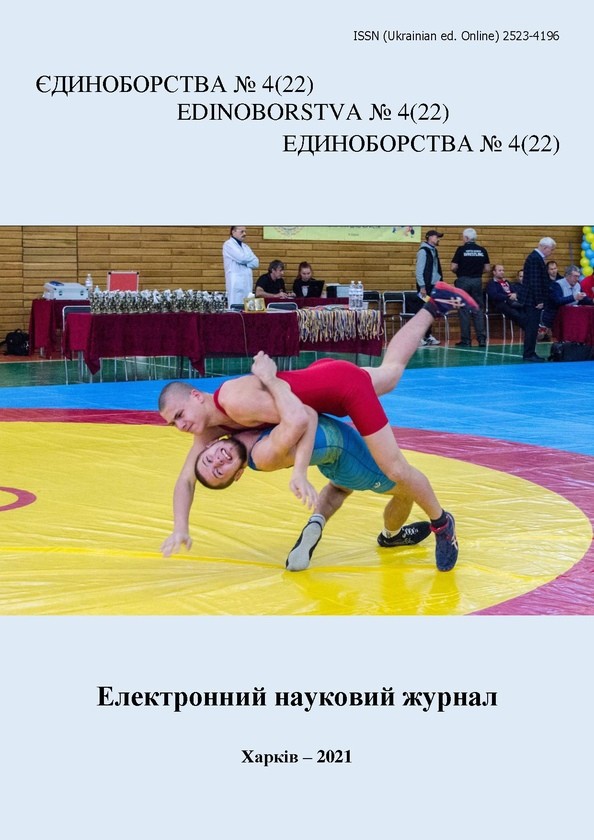Improvement of sports duel of kickboxers-juniors due to development of specific perceptions
DOI:
https://doi.org/10.15391/ed.2021-4.06Keywords:
kickboxing, specific perceptions, technical and tactical compounds, competitions, fightAbstract
Purpose: improve the methodology for preparing junior
kickboxers for sports fights due to the development of specific perceptions. Material and methods.
The following scientific methods were used in this study: theoretical analysis and synthesis of
scientific and methodological literature; pedagogical observations; instrumental method;
pedagogical testing; pedagogical experiment; mathematical and statistical research methods.
Results: а set of tests for tablet computers (Ashanin V.S., Romanenko V.V., 2015) was used to test
specific perceptions, such as «Sense of pace», «Sense of change in the size of the object»,
«Accuracy of reproduction of a given line». An instrumental method, namely video computer
analysis, was used to estimate time slots. To determine the time intervals, as a parameter that
displays the quality of the equipment, it was proposed to perform a technical-tactical combination
(TTC): «Jeb» (direct hand, near) - «Punch» (direct hand, far) - «Side-kick» (side kick). Based on
the study of scientific and methodological literature, pedagogical observations, conversations with
trainers, pedagogical tests were selected to evaluate the investigated indicators and a set of special
exercises was developed to improve the quality of sports duels of junior kickboxers. The results of
the pedagogical experiment indicate that the use of the exercises of the proposed complex of special
exercises positively affects the development of specific perceptions such as a feeling of pace, a feeling of distance, an opponent's feeling, a feeling of impact, etc. Increasing the level of
manifestation of specific perceptions positively affects the quality of technical and tactical actions,
which allows you to receive winning points in a sports match. Conclusions. It was determined that
at the end of the pedagogical experiment, the time intervals of athletes of the experimental group
are statistically significantly shorter (p<0,01) than the time intervals of athletes of the control
group. The difference between the indicators of special physical fitness in athletes of the study
groups at the end of the pedagogical experiment is not statistically reliable (p>0,05). Analysis of
the results of determining the sense of pace indicates that the indicators of athletes of the
experimental group are statistically significant (p<0,01) different from those of athletes of the
control group. Statistically significant improvement of tempo sense (p<0,01) and accuracy of
reproduction of a given line (p<0,05) is the cause of positive changes in sensory, motor
mechanisms of motion control. These changes caused a decrease in time intervals and improved
accuracy of striking in a technical and tactical connection. A comparative analysis of the results of
control fights showed that athletes of the experimental group performed technical and tactical
actions better and earned more winning points than athletes of the control group (W=29,5;
p<0,05).
References
Ашанин, В.С., & Романенко, В.В. (2015). спользование компьютерн х технологий для оценки сенсомоторн х реакций в единоборствах. Слобожанський науково-спортивний вiсник, № 4, 15-18.
Галочкин, П.В, Клещев В.В., & Клещев, В.Н. (2007). Показатели б строт и точности сенсомоторного реагирования у кикбоксеров различн х манер ведения боя. Спортивный психолог, №1(10), 25–28.
Козина, Ж.Л. (2008). Математическое моделирование индивидуальних особенностей спортсменов. Педагогіка, психологія та медико-біологічні проблеми фізичного виховання і спорту, 56–59.
Козіна, Ж.Л., & Демура, І.М. (2010). Результати застосування методів математичного моделювання для визначення індивідуальних тактичних манер ведення сутички у дзюдоїстів високого класу. Теорія та методика фізичного виховання, № 7, 17-38.
Коробейніков, Г.В., Аксютін, В.В., & Смоляр, І.І. (2015). Зв’язок стилів ведення поєдинку боксерів із психо-фізіологічними характеристиками. Педагогіка, психологія та медикобіологічні проблеми фізичного виховання і спорту, № 9, 33-37.
Коробейніков, Г, Приступа, , Коробейнікова, Л, & Бріскін Ю. (2013). Оцінювання психофізіологічних станів у спорті. (Монографія). Львів, Україна.
Ровн й, А.С., Романенко, В.В., & Пятисоцкая С.С. (2016). Методика контроля и анализа изменений частот сердечн х сокращений единоборцев под воздействием физических нагрузок с использованием компьютерного приложения. Слобожанський науковоспортивний вісник, № 6, 95-99.
Ровн й, А.С., & Романенко, В.В. (2016). Модельн е характеристики сенсомоторн х реакций и специфических восприятий единоборцев в сокой квалификации. Єдиноборства, № 1, 54-57.
Романенко, В.В. (2004). Корреляционная зависимость технической подготовленности новичков занимающихся таэквон-до от уровня развития чувства темпа и ритма. Слобожанський науково-спортивний вiсник, № 7, 75-77.
Романенко, В.В. (2008). Биомеханический анализ основн х при мов в полняем х ногами. изическое воспитание студентов творческих специальностей, 44-49.
Романенко, В.В., & Веретельникова, Н.А. (2019). Оценка биомеханических характеристик в ударн х видах единоборств с помощью мобильного приложения. Единоборства, 48-57.
Скирта, О.С. (2015). Вдосконалення техніко-тактичної підготовленості кікбоксерів на етапі спеціалізованої базової підготовки (Автореф. дис....канд.наук з фізичного виховання та спорту). Дніпропетровськ, Україна.
Menescardi, C., Lopez-Lopez, J.A., & Falco, C. et al. (2015). Tactical aspect so fanational university taekwondo championship in relation to round and match out come. J Strength Cond Res, 29(2), 466–471.
Podrigalo, O., Borisova, O., Podrigalo, L., Iermakov, S., Romanenko, V., Podavalenko, O., & Volodchenko, O. (2019). Comparative analysis of the athletes functional condition in cyclic and situational sports. Physical education of students, № 23(6), 313-319.
Romanenko, V., Podrigalo, L., Cynarski, W., Rovnaya, O., Korobeynikova, L., Goloha, V., & Robak, I. (2020). A comparative analysis of the short-term memory of martial arts athletes of different level of sportsmanship. Journal of Martial Arts Anthropology, № 20(3), 18-24.
Santos, V.G.F., F.de Oliveira Pires, & Bertuzzi, R. et al. (2014). Relationship between attack and pause in world taekwondo championship contests: effects of gender and weight category. Muscles, Ligaments and Tendons Journal, 4 (2), 127-131.
Jo, Y.M., Kim, Y.S., & Hong, S.H. et al. (2018). Kinematic Analysis of Taekwondo Koryo Poomsae for Accurate Scoring in Competition. Journal of the International Association for Taekwondo Research, 3(2),17-25.
Quel, O.M., Bennett, S.J., & Lopez-Adan, E. (2015). Сhoice reaction time is not related to competition success in karate combat. European Journal of Human Movement, № 35, 41-50.













